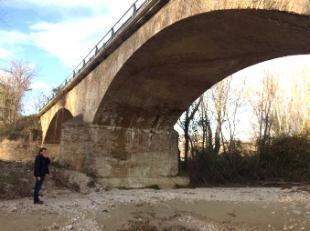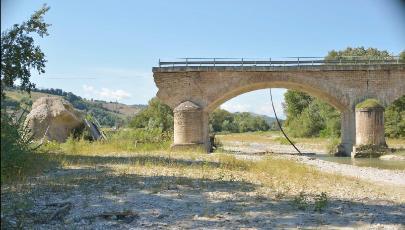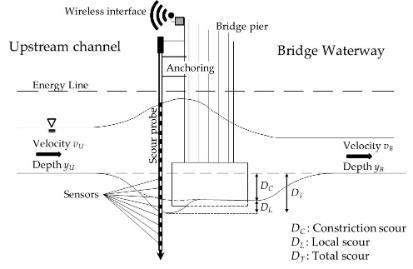What is bridge scour and how did we get involved?
Published: 15 December 2020
Dr Enrico Tubaldi and Dr Andrea Maroni, from the University of Strathclyde, explain what bridge scour is and why monitoring it is so crucially important to Scotland and its critical national infrastructure.
Dr Enrico Tubaldi and Dr Andrea Maroni, University of Strathclyde
Bridge scour is the biggest cause of bridge failure worldwide. This threatening process occurs due to the action of fast-moving water during floods removing sediment from the foundations of bridges located underwater, and jeopardizing their stability. The extent of the problem is enormous, considering that a significant proportion of bridges, in almost any country, cross waterways and were probably built years ago without particular consideration of it.
Bridge scour is the reason why we both moved to the UK. In 2015 Enrico was awarded a Marie Curie Fellowship for a two-year research project entitled "Flood Risk Assessment and mitigation for Masonry Arch Bridges" at Imperial College, London. Before then he was researching the performance of structures against earthquakes, another threatening natural hazard. The idea to propose a research piece on bridge scour came from the devastating effect of the 2013 flood in his region, Marche, resulting in the collapse of Rubbianello bridge (Figure 1). An inspection of that bridge and an investigation into how communities on both sides of the bridge were affected by the collapse sparked his interest in the problem. He decided to work at Imperial College because there was a group, led by Prof. Izzuddin and Dr. Macorini, who had developed very advanced techniques for analysing the behaviour of masonry arch bridges, which are the typology most vulnerable to scour [1].


Figure 1. (a) Enrico inspecting Rubbianello bridge (Italy) in 2014 (b) View of remains of Rubbianello bridge with pier foundations exposed due to scour.
Andrea also relocated from Italy, but to the University of Strathclyde to do a PhD on scour risk assessment and early warning for bridge scour. He developed a Decision Support System (DSS) for scour risk management of road and railway bridges based on Structural Health Monitoring (SHM) scour data and Bayesian networks [2]. During his PhD, he also developed a scour monitoring system based on dielectric probes currently installed at a masonry arch bridge in New Cumnock [3] and worked as research assistant in a NERC-funded project titled “Early warning decision support system for the management of underwater scour risk for road and railway bridges”.
Since then, we both carried on doing research on the topic and continuously engaged with UK transport agencies (Transport Scotland, Network Rail, and Highways England) to deploy practical solutions for monitoring scour in critical bridges and improving their resilience to floods.
Why is bridge scour a problem to communities?
In the UK, there are more than 60,000 road and railway bridges crossing waterways and around 95,000 bridge spans and culverts that are susceptible to scour. Scour was responsible for at least 138 railway bridge failures between 1846 and 2013, (i.e., a bridge failure every 2.44 years) [4]. Bridges in Cumbria, a non-metropolitan county in North West England, have been particularly affected by flood events in the last decade (Figure 2). Several of them were damaged in November 2009 and December 2015, including two scour-related collapses (Northside bridge and Pooley Bridge, respectively) [5][6]. The collapse of these bridges resulted in inconvenience and complications in transportation but it is also worth mentioning the implications in terms of loss of cultural heritage value to communities. In fact, the bridges that are most vulnerable to scour are the old, masonry-arched ones.

Figure 2. An aerial view of the destroyed Northside bridge in Workington (Cumbria) [7].
The winter storms of 2015 resulted in serious damage/destruction to bridges across Scotland as well. This included the Lamington viaduct, which resulted in the closure of the West Coast mainline between Glasgow and London for nearly two months due to a scour failure at one of its piers [8]. The recovery cost incurred by Network Rail (NR) amounted to over £6m. Transport Scotland (TS) is responsible for 1,600 bridges, including the Forth Road Bridge, and around 8% of those are currently classified as needing detailed consideration, such as possible monitoring and scour protection measures. £3.5m of known scour repairs and scour resilience works must be carry out in the near future.
A recent study by Lamb et al. [9] has estimated that the risk of bridge scour in Britain equates to an average of 8.2 million passenger journeys being “lost” annually, and the economic consequences of these can be valued at between £6m and £60m annually. The potential social and economic consequences of bridge failure from scour are particularly acute in remote parts of Scotland where road and rail networks are sparse and bridge closure could result in lengthy diversion routes, or even sever the only link to isolated communities.
The problem of scour is also exacerbated by climate changes in the UK, and particularly in Scotland, where an upward trend in winter precipitation could contribute to increased scour risk in the future, particularly for older bridge assets that have not been designed to withstand scouring.
Are Scottish bridges resilient and how is this project helping to improve bridge resilience to scour?
TS and NR have invested a lot in several strategies for mitigating the scour risk of their assets. These transport agencies routinely inspect their bridges, allocating a significant part of their budget to these tasks. For example, TS approximately inspects one third of its total assets each year, spending £2m on reactive visual exams that include underwater appraisal of the scour depth. The transport agency also invests in scour monitoring systems that are capable of providing quantitative information about scour depth at bridge foundations. TS funded the purchasing of the scour probes that were used to develop the scour monitoring system described in Maroni et al. [3] (Figure 3) as well as the installation at the Nith Bridge. And in the near future, three more probes will be installed in two bridges in South-West Scotland thanks to further funding from the Scottish Road Research Board.


Figure 3. Scour monitoring system installed at the Nith bridge in New Cumnock, UK [3]
Following the incident at the Lamington viaduct, NR has also implemented scour countermeasures and installed monitoring systems at the viaduct, such as a water level gauge and a network of tilt sensors for detecting structure movement caused by scour. The latter includes 48 inclinometers installed throughout the bridge to measure rotations of the abutments and the three piers.
Many scour sensors have been developed to date, but few have been deployed in practice. This might be due to their cost or the difficulties in installation and processing the large amount of data they produce. It may be due to lack of knowledge of the benefits stemming from the use of sensors. Thus, there is the need of rational procedures for the design of scour monitoring systems, and of metrics for evaluating their accuracy and performance.
SHM’s role is indeed key for an accurate evaluation of bridge scour risk, which is essential for meeting the challenge of developing resilient infrastructure and communities. The research funded by the National Centre for Resilience aims to quantifying the benefits of structural health monitoring for scour risk management of bridges in transport networks and evaluating them based on rational criteria. The research contributes to increase the application of sensors and scour monitoring strategies in real practice, thus enhancing the resilience of Scotland's critical infrastructure against the most severe of the threatening natural hazards. In fact, an effective scour monitoring strategy could help the transport operators in directing reactive inspections according to a more accurate scour risk classification and reducing the times that bridges might be closed unnecessarily as precautionary action. This can significantly contribute to the four dimensions (i.e., four Rs) of resilience against any natural hazard: (i) enhancing the infrastructure Robustness with useful information that defines optimal maintenance strategies; (ii) increasing the network Redundancy by identifying alternative paths when a network component is damaged; (iii) establishing priorities and mobilizing resources in case of emergency (Resourcefulness); and (iv) helping a speedy recovery after shocks by providing alerts to first responders (Rapidity). The first deliverable of the project can be accessed at the link provide below.
If you would like to know more about our research, please have a look at the references below and do not hesitate to get in touch!
References
- Tubaldi, E., Macorini, L., and Izzuddin, B. A. (2018), “Three-dimensional mesoscale modelling of multi-span masonry arch bridges subjected to scour”. Engineering Structures, 165, 486-500.
- Maroni, A., Tubaldi, E., Val, D. V., McDonald, H., and Zonta, D. (2020), “Using Bayesian networks for the assessment of underwater scour for road and railway bridges”. Structural Health Monitoring, https://doi.org/10.1177/1475921720956579.
- Maroni, A., Tubaldi, E., Ferguson, N. S., Tarantino, A., McDonald, H., and Zonta, D. (2020), “Electromagnetic sensors for underwater scour monitoring”. Sensors, 20(15), 4096.
- van Leeuwen, Z. and Lamb, R. (2014), “Flood and scour related failure incidents at railway assets between 1846 and 2013”, Project W13 - 4224, JBA Trust Limited 2014, Skipton, UK.
- Cumbria Intelligence Observatory (2010), “Cumbria Floods November 2009: An Impact Assessment”, Cumbria Intelligence Observatory, Cumbria, UK (accessed on 11th July 2018). URL: https://bit.ly/35Anses
- Szoenyi, M., May, P. and Lamb, R. (2015), “Flooding in Cumbria after Storm Desmond”, Zurich Insurance Group, Zurich, Switzerland, JBA Trust, North Yorkshire, UK (accessed on 20th July 2019). URL: https://bit.ly/2YzesoJ
- Byrne, P. (2009), “The Northside bridge collapse”, The Guardian. URL: https://bit.ly/2UoU4nf
- Rail Accident Investigation Branch (2016), “Structural failure caused by scour at Lamington viaduct, South Lanarkshire 31 December 2015”, Report 22/2016, Rail Accident Investigation Branch, Department for Transport, Derby, UK.
- Lamb, R., Garside, P., Pant, R., and Hall, J. W. (2019), “A Probabilistic Model of the Economic Risk to Britain's Railway Network from Bridge Scour During Floods”. Risk Analysis, 39(11), 2457-2478.
- Tubaldi, E., Maroni, A., Ferguson, N., and Zonta, D. (2020), “Report on critical review of alternative techniques for bridge scour monitoring”, National Centre for Resilience, Glasgow, UK. URL: https://sway.office.com/paZdmLnyF7wb5Zbh?ref=Link
First published: 15 December 2020
<< Blog

